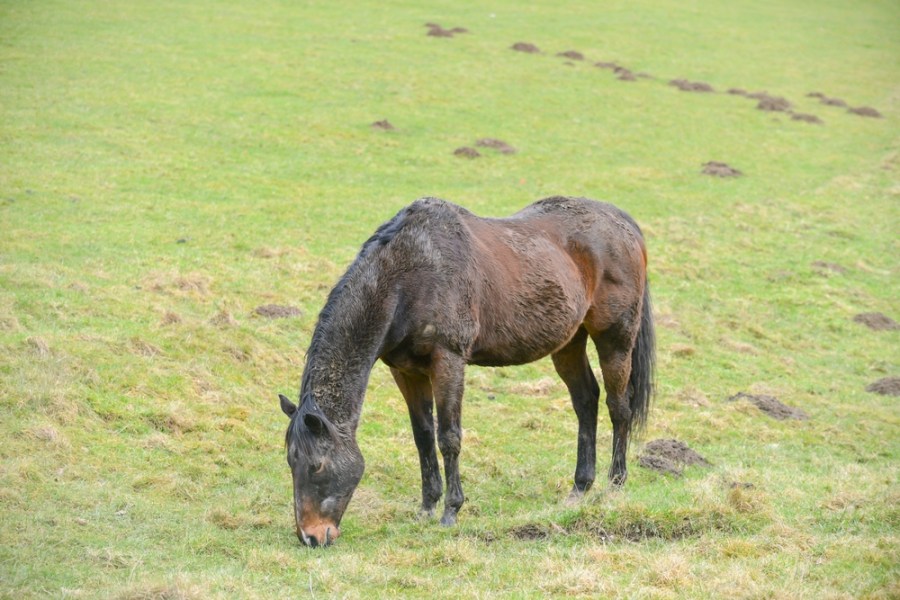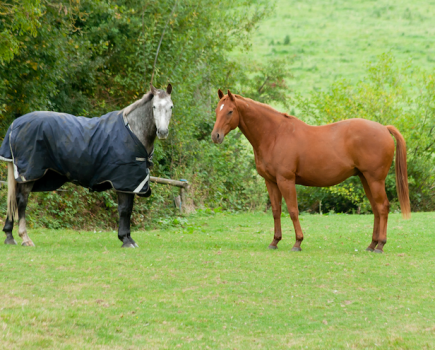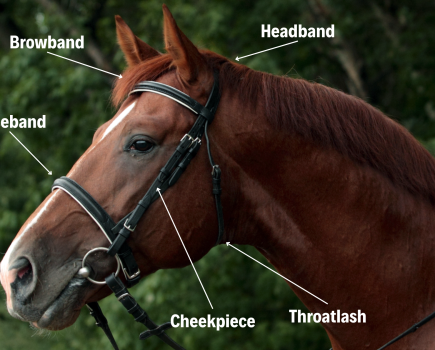It’s a question that stirs great debate among equestrians all around the world: when does a horse really need to wear a rug? Understanding how they stay warm will help you decide whether they do need an extra layer or when it’s best to allow them to use their body’s natural defences instead.
Every horse has an in-built cooling and heating system called thermoregulation. This is what keeps their body temperature within a certain range.
“Sensitive nerves and receptors in the horse’s skin, abdomen, skeletal muscles and parts of the spinal cord send messages relating to body temperature to the hypothalamus, which is the thermoregulatory centre within your horse’s brain,” explains anatomy expert Gillian Higgins from Horses Inside Out.
“Your horse’s hair also plays a key role in temperature regulation. They adapt to the colder weather during winter by growing a longer thicker coat. If you remove that coat by clipping it off, you will need to replace that lost layer with a rug.
“You may also notice that when your horse is cold their hair stands upright. This is to trap an insulating layer of air to warm them up.”
How horses keep warm
Horses in the wild don’t have a wardrobe of rugs to protect them when it gets cold and wet — and they don’t need them. This is because horses naturally keep themselves warm in three ways:
- Insulation
Your horse will use fat to generate energy and warmth. This is why not rugging a horse who is overweight helps to burn calories, because they use them to keep warm. - Vasoconstriction
This is when the capillaries under the skin contract, reducing heat loss. - Shivering
This rapid contraction of the muscles produces heat.
Over-rugging is generally a well discussed topic, not least because it can cause health problems.
“Knowing when horses need a rug is pretty obvious,” states scientist Dr David Marlin. “If you have a horse who is shivering, losing weight and doesn’t seem very happy, it’s time to consider putting on a rug.
“On the other hand, if you put your hand under the rug and the horse is sweating underneath, you know you are over-rugging.”
Dr Marlin talks more about when horses feel cold here — you might be surprised to learn at what temperature equines are likely to feel a chill, because it’s very different to a person’s!
When a rug isn’t needed
According to Dr Marlin, the difficulty with over-rugging is that it’s not always that obvious. The trickiest thing to judge is when the horse is too hot but isn’t sweating.
A study undertaken at Sparsholt College that used humidity sensors under the horses’ rugs found that horses start to sweat at around 25°C. That is the upper limit of the horse’s thermoneutral zone.
“In the study, the upper neutral limit was exceeded on every horse but only one presented with sweat, even though all the horses were severely over-rugged,” adds Dr Marlin.
“The key finding from the study was that when trying to assess this by just putting a hand under the rugs, sweating was only detected in one horse who was wearing four or five rugs. So we could tell by feel if a horse was severely over-rugged, but not when a horse was moderately over-rugged.”
Consequences of over-rugging
The consequences of putting on a horse rug when it’s not needed are that you’re creating a warm, humid environment under the rug.
“These are ideal conditions for bacteria and fungi, increasing the risk of skin infections. There’s also the issue of vitamin D deficiency, because if your horse is constantly rugged, there’s a reduction in the amount of sunlight reaching the skin,” says Dr Marlin.
“An over-rugged horse will also be using less energy to keep warm, which could potentially play a role in obesity. If you have a horse or pony who is overweight, over-rugging is going to exacerbate that.
“A horse who is overweight has already got a pretty high level of insulation. They don’t need a rug and taking off the rugs will potentially help that horse reduce their bodyweight.”
Rugging isn’t natural
“One of the problems we have with weight management in general is that we mess with the horse’s natural cycle,” continues Dr Marlin.
“In the wild, horses will eat everything that’s available in the summer, get well covered, and then lose this extra layer of fat through the winter, so that by spring they are looking on the thin side and the cycle starts again.
“What we try to do is the opposite, which is have them fit and lean in summer when they’re competing, and then over-feed and over-rug them in winter, encouraging horses to get fat, which results in incidences of metabolic syndromes.”
Dr Marlin’s key message is that rugging horses isn’t natural.
“Most cope well in the wild without our help and when we interfere, we often make things worse,” he explains.
“As long as they are in good health, have a good body condition score and access to shelter and ad-lib forage, many horses don’t need to wear a rug — or, if they do, they should only be lightweight rain sheets to prevent the horse getting wet and cold.”
Beware peer pressure
You know your horse better than anyone so try not to be influenced by what others are doing. Go with what is best for your horse. Most can manage perfectly well for the majority of the year without a rug on, even if there is a bit of a breeze or a spot of rain.
I can remember being at my livery yard one winter’s evening, preparing to leave. Every other horse had a thick full-neck stable rug on, with an extra layer underneath.
This was compared to my little Bee, who just had a standard neck stable rug on. I questioned my choice. If the chunky Irish Draught and Warmblood types, who dwarfed my 16.2hh Thoroughbred, were wrapped up, surely Bee also needed to be?
For the following reasons, I didn’t change his rug:
- Bee was only partly clipped with a blanket clip. The other horses were fully clipped.
- He had recently gone from living in a drafty old stable block that was outside (and he did have a thicker rug on then) to this draft-free indoor barn, which was naturally a lot warmer.
- It wasn’t predicted to be cold enough to freeze that night (and it didn’t).
- I’d owned him 10 years, and knew he was a warm little horse.
- He had ad lib hay, fed from the floor, and never ran out at night. So plenty to eat and fuel his body’s natural heat-producing process. The other horses all had a haynet, so their forage was limited.
Turns out, I made the right decision by doing what I thought was right for my horse, rather than following everyone else’s lead. Bee wasn’t too warm when I removed his rug in the morning, and he wintered well.
These horses need a rug
Horses more likely to need a rug on, especially overnight and when the temperature is very low, include:
- Elderly horses
- Very young horses
- Sick horses
- Those who are underweight
- Horses cooling/drying off after sweating during exercise or being washed on a cold day
- Those who are fully clipped in winter.
Rug weights
Rugs are available in different weights. It’s a bit like the tog rating we look at when we’re buying a new duvet: the weight refers to the amount of filling inside that blanket and how warm it will keep your horse.
Considering the time of year and how your horse copes in different temperatures will help you choose the most appropriate weight of rug for them. Remember every horse is an individual, so even if the steed in the stable next door is wearing a heavyweight in the winter, a lightweight might be plenty for yours.
Lightweight horse rugs
Lightweight horse blankets usually have between 0g and 80g of filling, but they may have up to 150g of filling. You may also see/hear these described as rain sheets.
They keep your horse clean and dry, making them a good option for damp spring and autumn days, or cool summer nights.
You’ll choose a lightweight turnout when your horse is in the field and it’s raining, but it’s also warm and so you don’t want to add unnecessary layers. It’s useful to have one in the horsebox at a competition so that you can put it on your horse while they’re tied up outside if it begins to rain.
Many horses who aren’t clipped or who have a small clip will be plenty warm enough in a lightweight rug even in winter, especially if they are a hardy breed or a cob or are overweight.
Mediumweight horse blankets
Medium weight horse blankets tend to have between 100g and 250g of filling. For many horses this will be all they need to keep them warm and dry through the winter months.
The bit of padding inside a medium weight horse rug offers protection on really cold, frosty and windy days, but not so much that a horse may overheat.
It’s usual to have different weights of rug for the same horse too. In winter, for example, you may find that your horse needs a mediumweight to wear in the field where they are exposed to the elements, but only a lightweight in the stable, which is sheltered and therefore much warmer.
Heavyweight horse rugs
You’ll know when you’re dealing with a heavyweight horse blanket, because they are heavy. Often they take longer to dry after a soggy day in the field too, so bear this in mind.
Heavyweight horse rugs are exactly what the name suggests: thick, heavy rugs containing over 300g of filling. These are likely to be used in areas of the world where temperatures plummet well below freezing.
A horse who is fully clipped may benefit from wearing a heavyweight blanket, as can horses who are old or finer breeds, such as Thoroughbreds.
In areas of the world where the temperature is inconsistent, such as the UK, don’t be surprised if you find yourself swapping between a lightweight, mediumweight and heavyweight rug regularly, even in winter.
Always rug according to what the temperature actually is and what suits your horse’s requirements. Don’t just assume that because it’s winter it must be very cold.
Golden rules for using a horse blanket
- Don’t rug your horse based on how cold you feel. They can cope with a dip in temperature much better than you can.
- Old, young, underweight and clipped horses will feel the cold more and may need rugging up or wearing a heavier weight of rug compared to other horses.
- For most horses, rugs and blankets shouldn’t really be needed until the night time temperature is between 5°C and 10°C.
- Start with a simple lightweight rug. This may be all your horse needs. You then have the option to move to a heavier weight rug if it gets really cold.
- Wind and cold temperature combined lead to the greatest heat loss.
- Remember the winter months are the ideal opportunity for those horses who are carrying a bit too much weight to lose a few pounds. This won’t happen if you rug them up as your horse will use less energy to keep warm.
- As the temperature drops, if your horse doesn’t have access to shelter, they will need a thicker waterproof rug.
- Feeding your horse plenty of hay will help to keep them warm too as the digestive system generates heat as the horse eats. This is another reason why it’s not always necessary to increase the weight of a rug the horse is wearing for them to feel the benefit.
- An indicator that your horse is at a comfortable temperature is putting your hand under their rug just behind the withers. If they feel cold, a thicker rug might be needed.
Enjoy the sun
I personally love buying rugs, putting them on my horse and seeing him wearing them. It’s a running joke in my house that my horses have a better wardrobe than I do. (It’s true.)
One of my favourite sights, though, is seeing my horses in the field naked, enjoying the sun on their backs and rolling in mud. Sure, it makes for a longer grooming session, but they’re so much happier after time spent without a rug on.
My final piece of advice when considering which rug or blanket to put on your horse (if any) is that this equine wardrobe staple shouldn’t be viewed as a fashion item.
Don’t be sucked in by all the lovely colours and patterns; a horse blanket has an important job to do in caring for a horse, and choosing the correct horse rug is vital. It’s crucial to know when your horse or pony might not need to wear one at all.
Main image © Shutterstock









